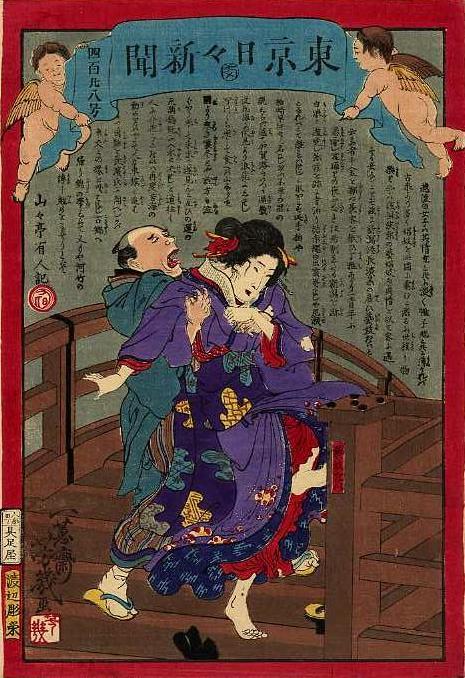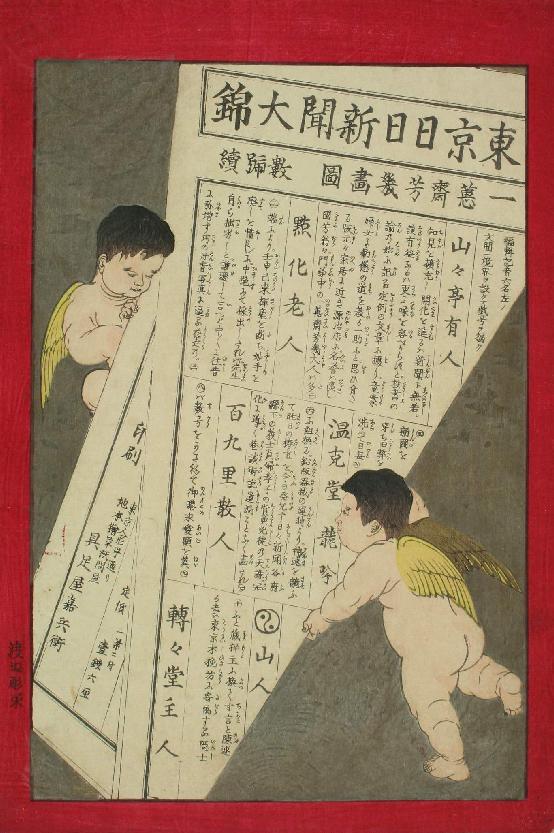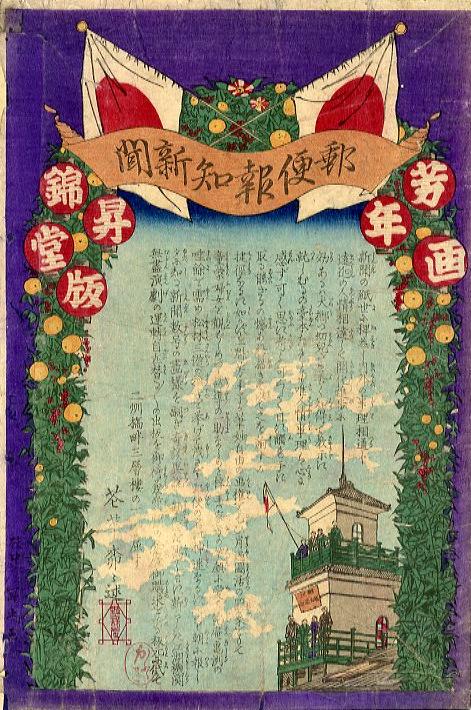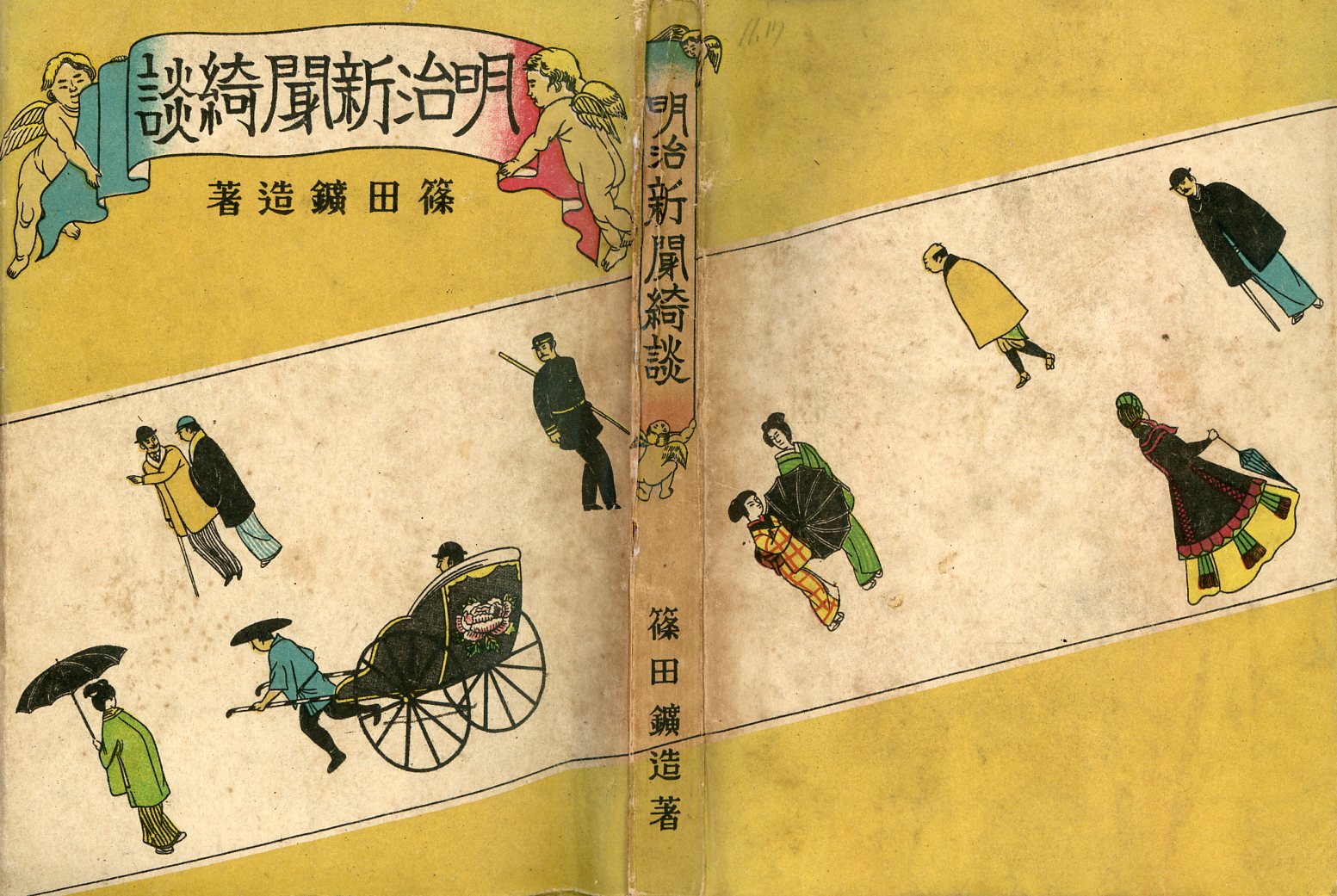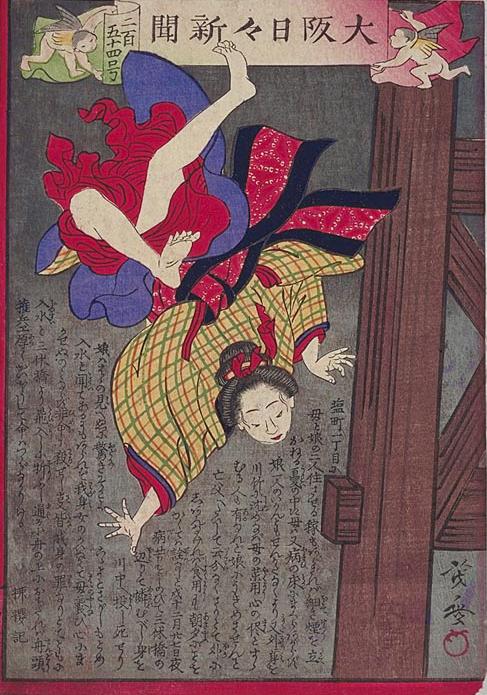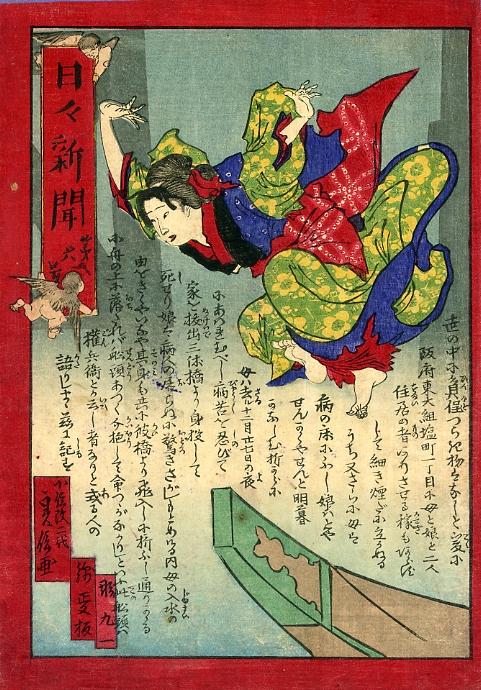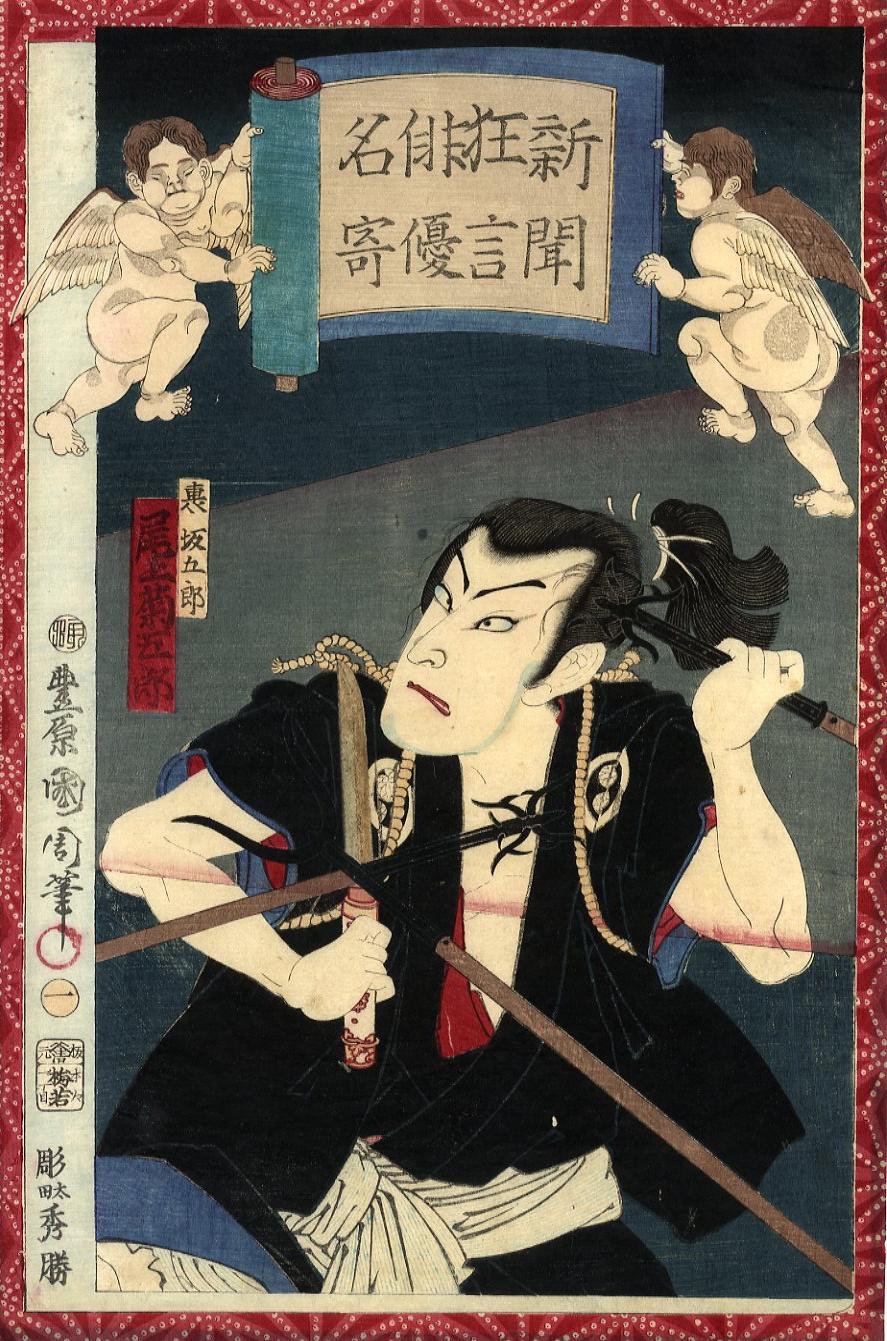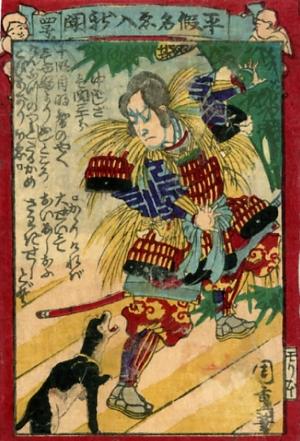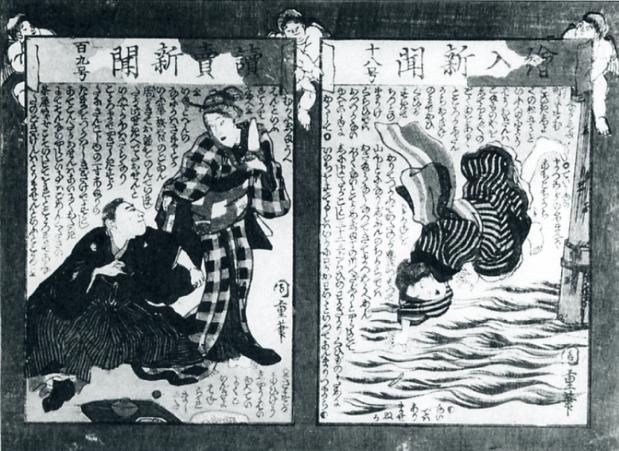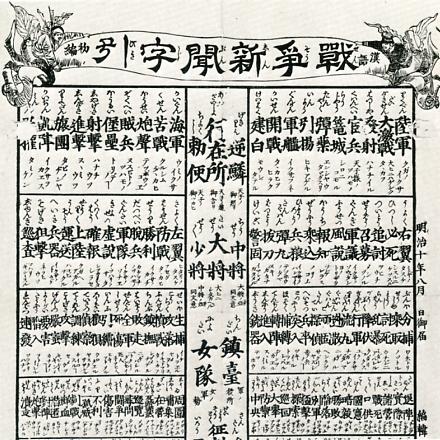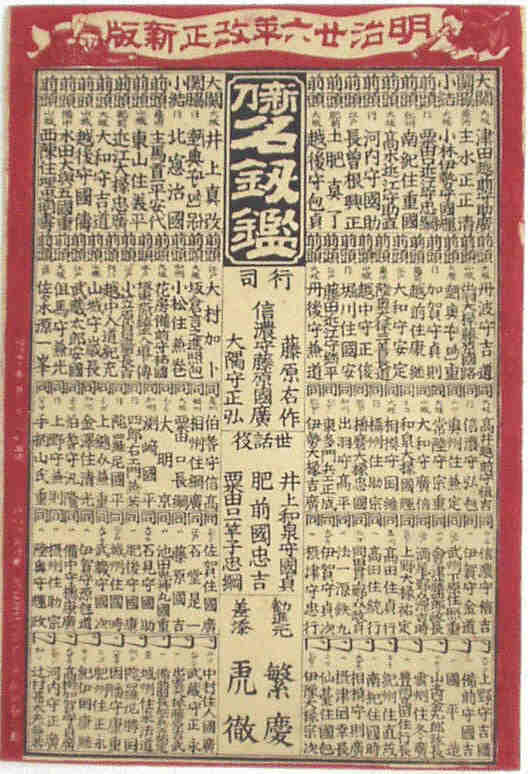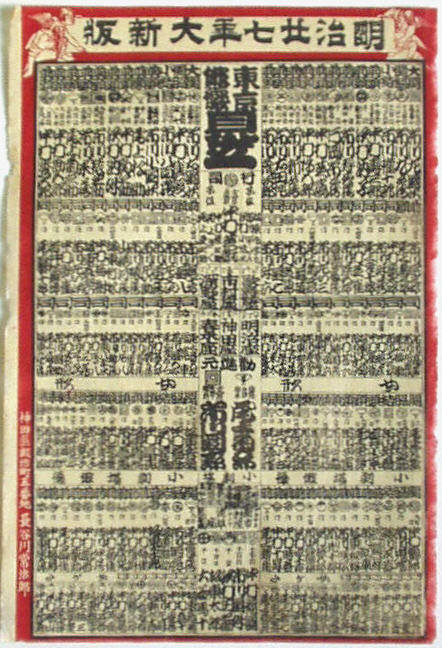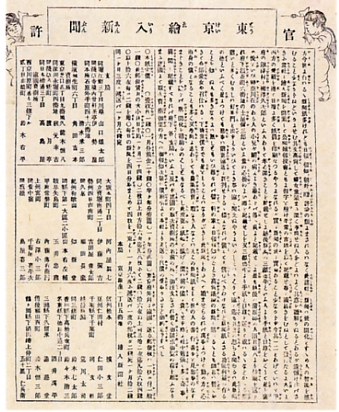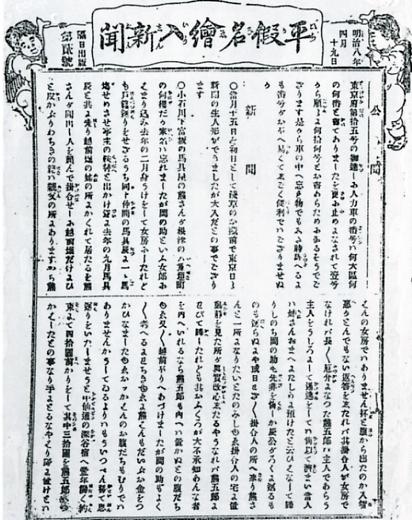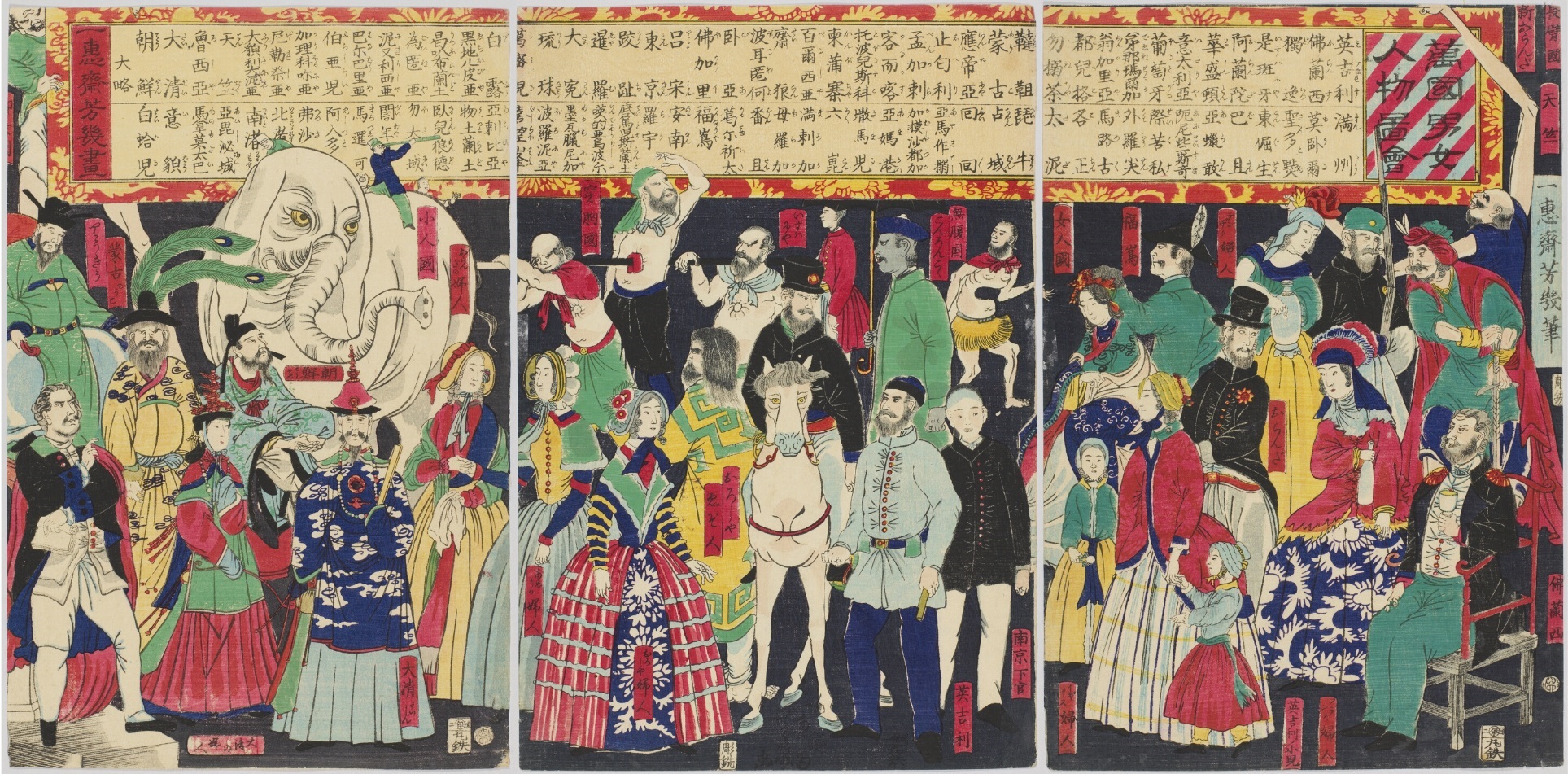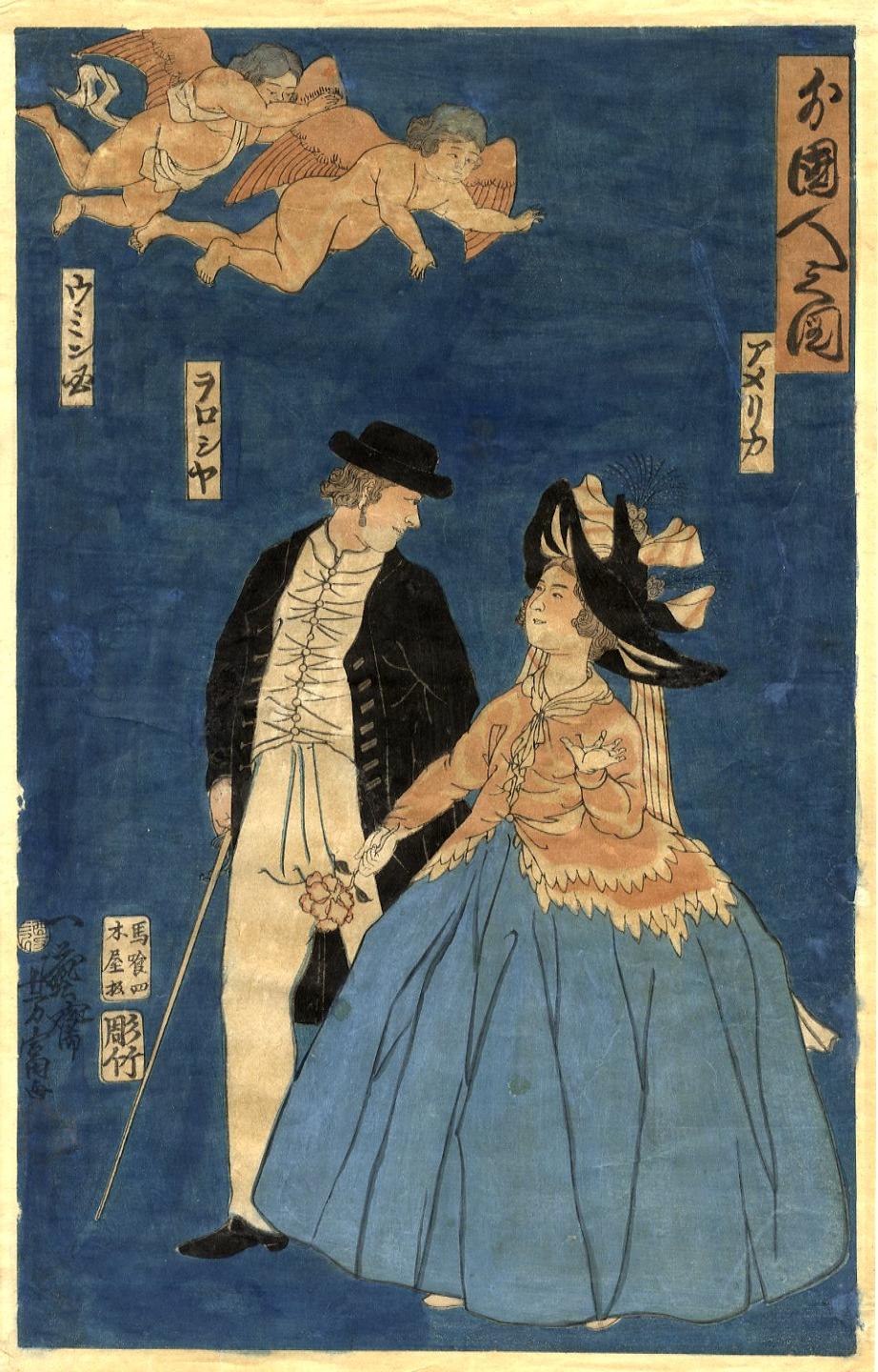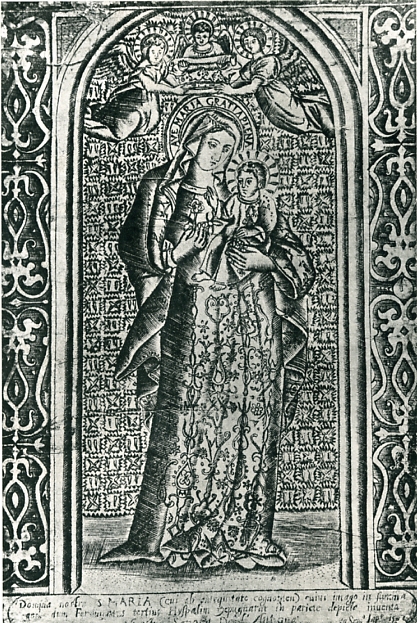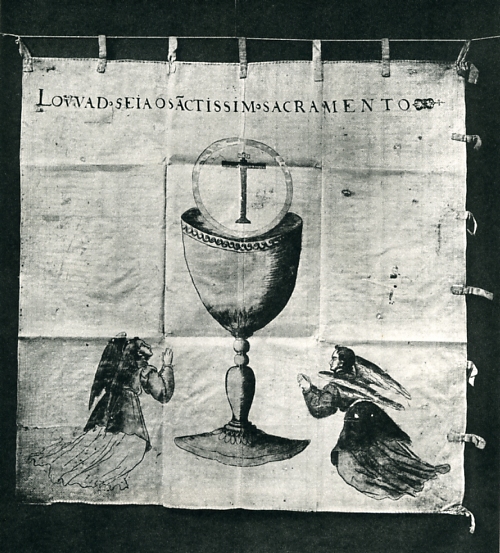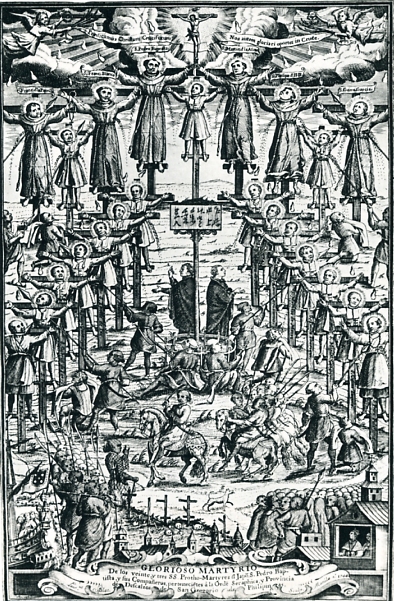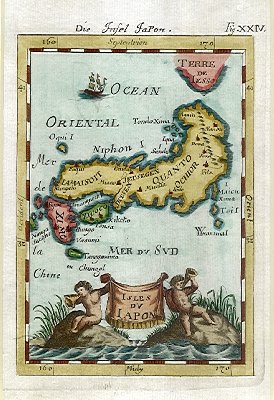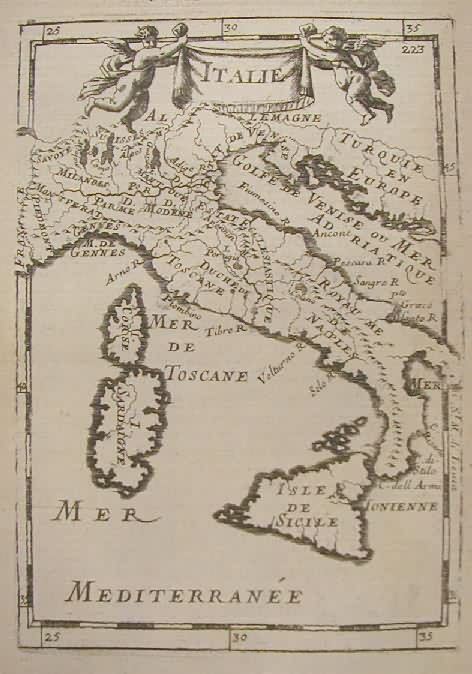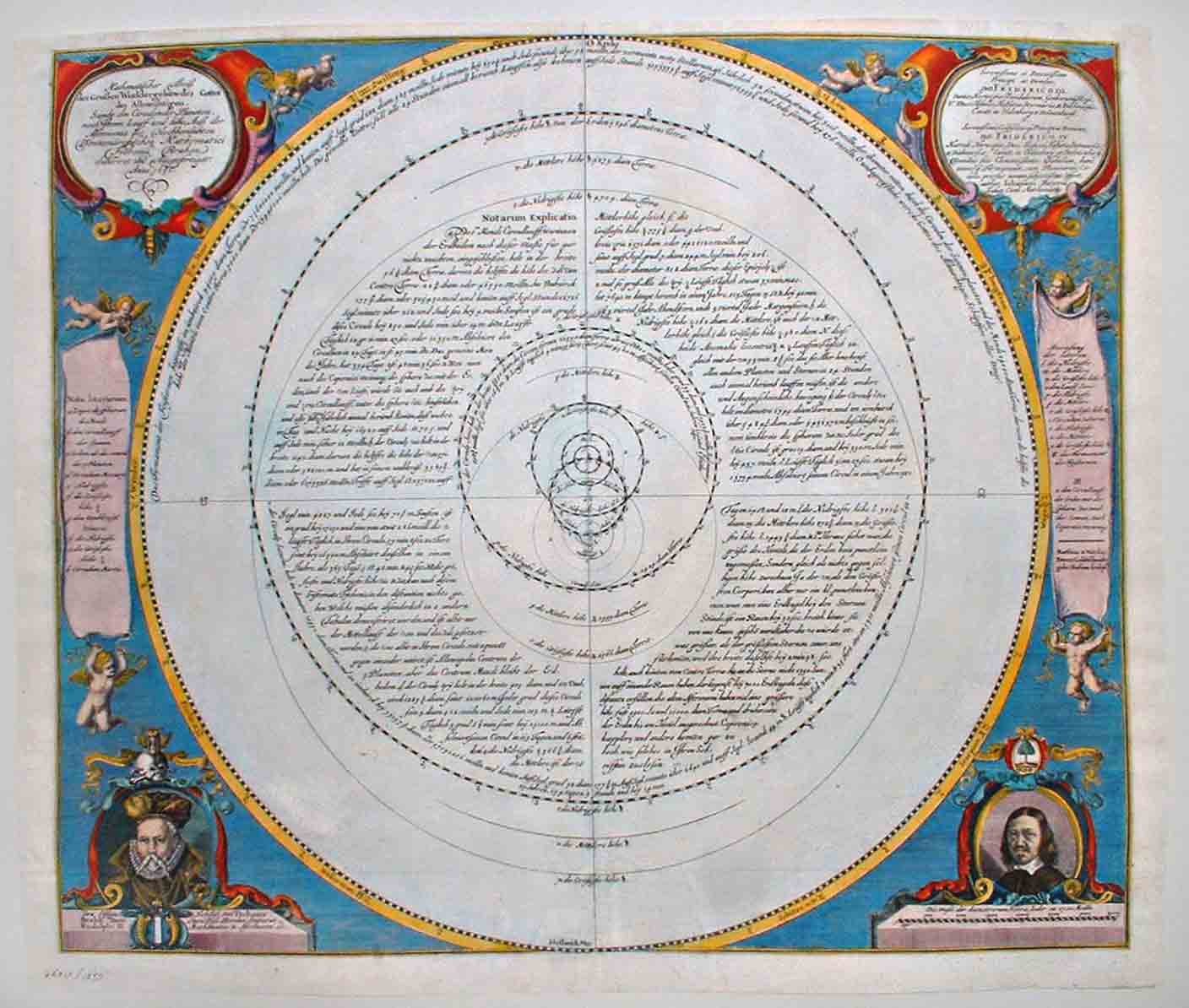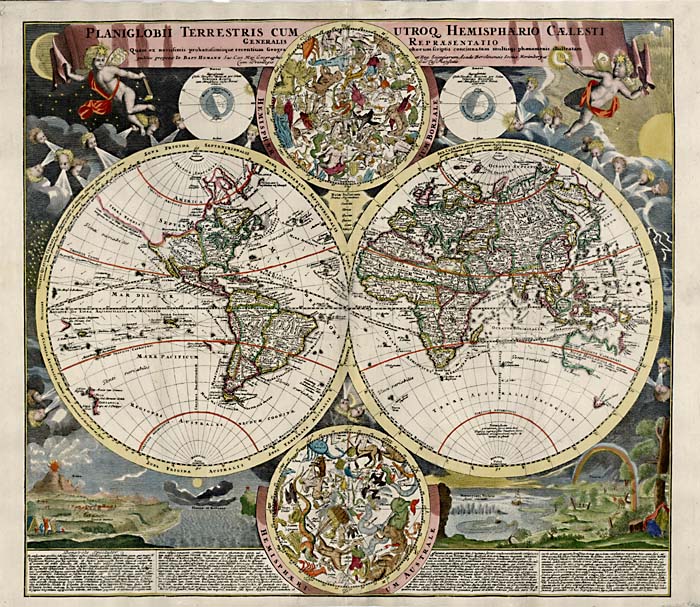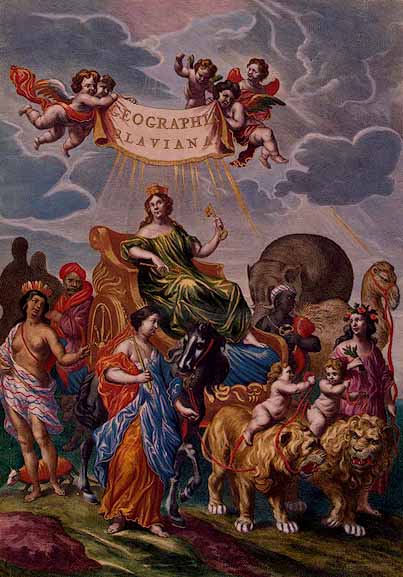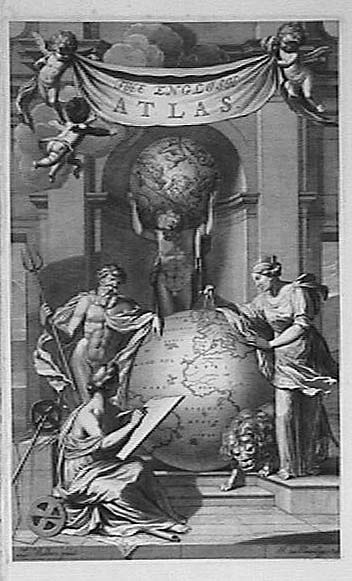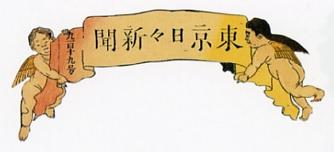
|
Winged people, cherubs, and banners
On late-Edo woodblock prints and early-Meiji news nishikie
By William Wetherall
First posted 23 July 2005
Last updated 15 January 2022
Plump putto publicists
Winged infants pressed into the service of Tokyo nichinichi shinbun nishikie bannermen
Other nishikie and papers
Osaka news nishikie
•
Kabuki nishikie
•
Mameban news nishikie
•
Mitate banzuke
•
Tokyo eiri shinbun mastheads
Bankoku danjo jinbutsu no zue (1861)
Ezo, Ryūkyū, Chōsen
•
Taiwan
•
Tonkin
•
Nankin, Taishin, Manshū
Yoshiiku's sumō prints
"Uminkoku" and other fabulous countries
Kuniyoshi's Asahina prints (1829, 1843)
•
Yoshitomi's "Gaikokujin no zu" (1861)
•
Ikoku monogatari (1658)
Other inspirations
Cherubs and banners in Christian art
•
Cherubs and banners on maps
Plump putto publicistsYou may have noticed the bare-butt putti holding the banners of the news nishikie to the right. No? Well, look again. Banners borne by boys with wings are common on news nishikie. Ochiai Yoshiiku (1833-1904), in association with the publisher Gusokuya, seems to have been the first to use such a design on a woodblock print, beginning with the Tokyo nichinichi shinbun onishiki promotional sheet published during the summer of 1874. The announcement of the start of Yubin hochi shinbun news nishikie featured an unfurled banner but no cherubs. Stage 1 and 2 YHS news nishikie showed the title of the source paper in a conventional box cartouche (see Cartouches below). Stage 3 prints are defined by variations of the banner used on the promo print, but again without cherubs (see YHS Three States under Articles). Where did Yoshiiku, if not Gusokuya or someone else associated with the design of the Tonichi news nishikie, come up with the idea of a masthead featuring cherubs holding a banner? Are there earlier examples in Japan? On domestic art or printed matter, whether nishikie, kawaraban, or maps? On on art or printed matter brought into Japan from other countries? Kuniyoshi's libraryThere are tens of thousands of items in publicly accessible collections and books in Japan. I have seen a few thousand items, mostly nishikie and kawaraban in books and mooks covering the late Edo and early Meiji periods, roughly two decades before and after 1868. However, I have yet to find a single item that could have inspired Yoshiiku's cherub-borne banner design. Since cherubs originated in Europe, perhaps Yoshiiku got the idea from something he had seen in a work or publication of European or possibly American origin. Yoshiiku probably crossed paths with all sorts of people in the late 1860s and early 1870s. He might have seen something somewhere, brought to Japan from Europe long ago, or brought more recently by an American or European, or by a Japanese who had traveled abroad on one of the several missions the government had sponsored during the late Edo and early Meiji years. Yoshiiku might have seen something in the library of his mentor, Utagawa Kuniyoshi (1797-1861). Kuniyoshi is known to have built a respectable collection of materials related to European art. All of his disciples, most notably Yoshiiku, designed a number of prints that intentionally incorporated European elements of style in portraits and landscapes. Yet there are no cherubs on such prints, or on any prints I have seen by Kuniyoshi or his disciples -- until Yoshiiku's Tonichi news nishikie. Cartouches representing unrolled scrolls appear on a number of pre-Meiji woodblock prints, as scrolls are a familiar form in Japan. Cartouches resembling bulletin boards also appear. But not banners of the sort that unfurl, much less banners held in the air by cherubs. The only example I have seen of a cartouche held by hands, though of men rather than cherubs, which predates the Tonichi news nishikie, is on a 1861 print designed by Yoshiiku (see Bankoku danjo jinbutsu zue below). The Illustrated London NewsYoshiiku apparently saw issues of the Illustrated London News in the early 1860s. The few pictures I have seen of this paper do not show cherub-borne banners. I queried The Illustrated London News Picture Library in the UK. Staff kindly looked for cherubs on the front pages of issues from the early 1860s but reported that saw no cherubs. I have not made an exhaustive study of mastheads on other contemporary European or American newspapers that Yoshiiku might have seen. But the mastheads I have seen of other mid 19th century papers have not had cherub-borne banners. Other possible sourcesWhat else might Yoshiiku have seen? Cherubs are not uncommon in European decorative art. They appear on furniture and silverware. They are found on buildings and other monuments. Perhaps Yoshiiku saw a painting or engraving or even a photograph of cherubs holding the capitol of a column or a cornice. Or of cherubs above the arched portal at the entrance of a building, holding an unrolled scroll which shows the building's name and dedication. Or of cherubs holding a coat-of-arms on a mansion. Or of cherubs at the corners of a family name cartouche on a tombstone. Or of cherubs looking down on from the vaulting of a cathedral or chapel. Most likely sourcesA more obvious source, however, would be Christian art, simply because cherubs are usually associated with Christianity, and Christianity had come to Japan in the 16th century (see Cherubs and Banners in Christian Art below). A less obvious but more likely candidate turns out to be European maps, which often featured cherubs and other holding banners or banner-like cartouches showing titles, scales, or legends (see Cherubs and Banners on Maps below). |
||||||
Cherubs on other nishikie and papersSome other nishikie published in Tokyo and Osaka during the early Meiji period -- including Ōsaka news nishikie and mameban news nishikie, but also a few non-news nishikie -- also featured cherubs upholding banners. At least one newspaper also briefly employed cherubs to hoist its banner. My impression is that all contemporary uses of cherubs were inspired by Yoshiiku's Tonichi news nishikie prints. |
Kabuki nishikieThe woodblock print to the right is represented as the 1st in a series. Numerous kabuki prints produced in 1875 and 1876 featured title cartouches held by cherubs, but none were as bold and spectacular as this one, by Toyohara Kunichika (豊原国周 1835-1900). Prints featuring popular kabuki actors, playing particular characters in specific performances, ranked with landscape prints among the most popular woodblock publications. Fans bought prints of their favorite actors or performances, much like fans of popular singers, movie stars, and athletes today buy their cards, photobooks, and biographies. Not a few nishikie designers specialized in kabuki prints, which depicted popular actors playing particular roles in specific performances. Drawers who worked mainly in other genres also at times accepted commissions to draw kabuki prints, but most prints were designed by drawers known for their adeptness at capturing actors in character. See SKHN-01 for other details about this print, its drawer, and the play it celebrates. Cherubs take front stageI don't collect, and have no personal interest in, kabuki prints as a genre. But three things about this "Shinbun kyogen haiyu nayose" print interested me when it was offered by a San Francisco print dealer. My email response to his offer was as follows.
|
Mameban news nishikieIn addition to oban (roughly B4) news nishikie in Tokyo, and chuban (roughly B5) news nishikie in Kansai, some rather crude news nishikie were published as mameban ("bean prints"), which were miniature prints, some as large as half a chuban (roughly B6), others as small as a playing card. Both prints shown here are attributed to [Morikawa] Chikashige (dates unknown), who judging from his name may have been a student of Kunichika. The first print, in color, is not much larger than a playing card. The print was based on a story in the Number 4 issue of Hiragana eiri shinbun, a bi-daily which published its first issue on 17 April 1875. This print, then, would be later than April 1875. Double duty cherubsThe second print, scanned from a black-and-white reproduction in the Meiji (first) volume of Shimonaka Kunihiko's Meisaku sashie zenshu [Complete collection of famous illustrations] (Tokyo: Heibonsha, 1979-1981), features two mameban prints on a single sheet. The right half is Eiri shinbun Number 18, hence late May 1875. The left half is Yomiuri shinbun Number 109, which would have come out about the same time, since the Yomiuri, a daily paper, published its first issue on 2 November 1874. Most interesting about this print is the use of three cherubs to hold two banners, so the cherub in the middle has to pull double duty. They are holding what looks more like unrolled scrolls than unfurled banners. But the cherubs are very similar to the plump putti on Tokyo nichinichi shinbun nishikie mastheads. In fact, the face of the middle cherub is that of the Stage 2 cherub then in use on TNS news nishikie (see TNS Four Stages under Articles). The Eiri, of course, had adopted the Tonichi nishikie cherubs and banners on its earliest issues (see Tokyo eiri shinbun below). |
Cherubs on mitate banzukeAs we have already seen, Yoshiiku's Tonichi news nishikie masthead was widely emulated by other news nishikie. It also had a continuing impact on masthead and cartouche design of other publications as the Meiji era unfurled. Two interesting variations appear on a series of mitate banzuke published in the mid 1890s. A banzuke is a ranked list, typically of sumo wrestlers that are to compete in a tournament, or actors that are to appear in a play. Such banzuke function as programs or playbills. A mitate is a likening of one thing to another, as a comparison, analogy, or parody. A typical mitate banzuke is a list and rank things in a manner analogous to a ranked list of sumo wresters. Mitate banzuke may also divide a list into "right/left" halves, again analogous to the "east/west" division of a sumo banzuke. The banzuke format is used to compare or rank virtually any subject, ranging from popular drawers to the best spas and restaurants, good and bad housewives, whatever. The format is commonly used today in magazines to list the best or worst this or that, in terms of price, quality, popularity, whatever. Cherubs join the army and see KyushuThe top banzuke to the right was published in August of 1877 near the end of the Seinan War that began in January that year. It is a "first edition" (初編)" [possibly "new edition" (新編)] of a "War newspaper dictionary" [Senso shinbun jibiki] featuring "Chinese words" [kango] that frequented newspapers at the time. Above the selected compounds are their Sino-Japanese pronuciations. Below are their meanings in Japanese. The cherub on the right, in proper military uniform, represents the government army. The cherub on the left is dressed in standard disenfranchised samurai rebel chic complete with headband. Source: Heibonsha 1978.3:51. Sword banzukeThe leftmost of the 2 re-bordered banzuke shown to the right is a "Meiji 26 [1893] revised new edition" [Meiji nijuroku-nen kaisei shinpan] of a banzuke entitled "New swords / Mirror of famous blades" [Shinto / Meiken (Mei tsurugi) kagami]. The swords are listed by place and smith, in the order of sumo ranks, beginning with Ozeki -- there are no Yokozuna. Some of the place names, including Edo, fell off official maps at the start of the Meiji period in 1868. Knowing nothing about swords, I cannot tell if the list is serious or playful. I suspect the latter. The jesters (?) holding the banner certainly seem to be having fun. The one on the right is looking at the banner through a telescope. The one on the right is brandishing a brush. Notice a simpler right-left distribution of telescope and brush on the masthead of Tokyo eiri shinbun (see Tokyo eiri shinbun Mastheads below). At least two earlier banzuke of similar design, one on arts, one on famous places, both with Meiji 24 nen kaisei shinpan [1891 revised new edition] banners, show jesters (?) right and left holding brushes (Seen 19 August 2005 at antiquarian book fair in Ikebukuro). Kabuki actor banzukeThe rightmost of the 2 red-bordered banzuke shown to the right is a called "Meiji 27 [1894] big new edition" [Meiji nijushichi-nen daishinpan] and is a "Comparison of Tokyo actors" [Tokyo haiyu (yakushi) mitate]. The actors are kabuki actors. This is not a kabuki playbill but just a list of actors, shown with (apparently) the crests of their families. Again, I do not know enough about the subject to determine whether the list is playful. The cherubs are older than Yoshiiku's. |
Tokyo eiri shinbun mastheadsHiragana eiri shinbun was started by Ochiai Yoshiiku, Takabatake Ransen, Nishida Densuke, and Okada Jisuke, all of whom were connected with the Tokyo nichinichi shinbun. The first issue was published on 17 April 1875 as a bi-daily. The paper became a daily, and was renamed Tokyo hiragana eiri shinbun, from 2 September the same year. Takabatake is named as the editor from September through December. From January the following year he moved to Yomiuri shinbun. From 2 March 1876 the paper became simply Tokyo eiri shinbun. It ceased publication in March 1889. Eiri as sister publication of TonichiHiragana eiri shinbun was published by Hiragana Eiri Shinbunsha, a company set up by Nipposha. From 16 April 1875, the day before the first issue, Tonichi ran a total of eight ads promoting the new paper, announcing the establishing of this new company and its paper. Apparently these ads were not run in other papers. The ads state that, as its name implies, the new paper will use mostly hiragana and will not use "kango far from the ear" [mimitooki kango], and it every issue will include ample illustrations. The ads also specify that Tonichi will distribute the first three issues free of charge to all its own readers, which suggests that Nipposha intended Eiri and Tonichi be sister publications. Eiri as replacement of Tonichi nishikieYoshiiku and Takabatake, while working at Nipposha's Tokyo nichinichi shinbun, were also busy drawing and writing for Gusokuya's Tonichi nishikie. Having launched the illustrated paper in April 1875, they gave less time to the news nishikie. In fact, it is very clear that the number of news nishikie issues begins to drop during the summer, and the last datable issues, reporting mostly June stories, have August approval seals. The last seventeen (17) Tonichi nishikie draw stories from fifteen (15) May and June issues and two (2) early July issues of Tonichi. Seven (7) have approval seals, all dating August 1875. All but three stories are signed, and all the signed stories are attributed to Tentendo (Takabatake). From September -- precisely at this juncture when Tonichi news nishikie vanish (the handfull of prints that appeared in the fall of 1876 are not, strictly speaking, part of this series) -- Eiri changes its name and becomes a daily, and Takabatake formally takes the editorial Helm. It is clear that Yoshiiku and Takabatake abandoned the Tokyo nichinichi shinbun nishikie series during the period they are launching Hiragana eiri shinbun. Tsuchiya goes so far as to suggest that the Tonichi nishikie directly led to the start of the Eiri as an illustrated paper. Both publications, she says, shared the idea of showing news as pictures -- pictures drawn, and news written, by the same new media mavericks. Et tu, Gusokuya?If not from Eiri's conception, then very shortly after its birth, during the very early weeks and months of its infancy, Yoshiiku and Takabatake saw that the Tonichi nishikie had no future, at least not for them. Gusokuya might have found others to continue to draw and write selected stories, but apparently he saw no profit in doing so. Only occasionally, in late 1876, did Gusokuya, as Fukuda Kumajiro, resurrect the cherub-borne Tonichi banner on a few prints, mostly triptychs of rebellions on the eve of the Seinan War, which broke out in January 1877. In publishing such prints, Fukuda was probably exploiting public interest in the civil disturbances, analogous to putting out special issues today of magazines and other publications full of photographs of a recent major disaster or even felicitous event. Sources: Tsuchiya 1995:22-24, 2000:83-85. 1874 Eiri cherub mastheadIf Yoshiiku lost interest in Gusokuya's Tonichi nishikie, he did not lose faith in its cherub-borne banner. The Hiragana eiri shinbun masthead was clearly adapted from the Tonichi nishikie masthead. The furl on the right of the banner shows the date, Meiji-8-4-19, or 19 April 1875. The furl on the left states that it is published every other day, and that it is the 2nd issue -- the 1st issue having been published on 17 April -- the paper was first published every other day. The masthead is done entirely by hand. The text in the paper, however, has been printed with moveable type, which in just a few years had replaced woodblocks as the means of printing text in newspapers and magazines. Source: Tsuchiya 1995:25. 1876 Eiri cherub handbillThe earliest issues of Tokyo nichinichi shinbun, which began in the spring of 1872, were printed off woodblocks on which the text had been hand carved. Yoshiiku was instrumental in introducing moveable type presses at Nipposha. Moveable type had become the standard for newspapers by the spring of 1875, when helped launch Hiragana eiri shinbun. By spring 1876, when Eiri began its third phase as Tokyo eiri shinbun, its masthead also sometimes used moveable type, as it does on this handbill [hikifuda], dated March 1876. The handbill advertises the new name, shown in a rather stiff banner held at either end by the familar plump putti. The two characters, on the folds at either end, read "kankyo" and indicate that the paper is one the government has permitted to be published. Source: Newspark 2001: 63. Later Eiri cherub mastheadThe ornate masthead to the right began to be used sometime before this edition, Issue 668 of 6 September 1877, a Thursday. The cherubs have lost their wings and are now printer's helpers. Notice the telescope and globe on the right, and the painter's palette with brushes on the left. On the Sword Banzuke (see Cherubs on Mitate Banzuke above), the jester on the right is looking through a telescope, and the jester on the left is holding a brush. |
||||
|
"Bankoku danjo jinbutsu zue" cartouche |
||||||||||
Strike breakersIn the spring of 1861, migratory Umin, permitted by the Shōgun to alight in the Kantō area and engage in trades that required their innate skills, went on strike to demand alightment and employment rights in other areas of the realm. They then protested Yoshiiku's deployment of Zainichi Longlegans (Chōkyakujin 在日長脚人) and Zainichi Longarmans (Chōhijin 長臂人) as banner-bearers in the extraterritorial foreign settlement in the new treaty port in Kanagawa. A motley assortment of Yokohama aliens, representing myriad real and imaginary countries, gathered in support of the longlimed strike breakers, who demanded equal employment rights. "Bankoku danjo jinbutsu zue" (萬國男女人物圖図會) [万国男女人物図会] is a masterpiece of realism and humor on late Edo woobclock prints. It shows how Ochiai Yoshiiku (1833-1904), its drawer, exhaled the atmosphere he inhaled in the studio of his mentor, Kuniyoshi (1798-1861). Kuniyoshi died on Bunkyū 1-3-5 (1861-4-14) and Yoshiiku's "Bankoku" or "All countries" triptych was approved for publication in the 4th month of Bunkyū, which straddled May and June 1861. I would like to think of the print as Yoshiiku's tribute to his Kuniyoshi's talent for treating the serious and absurd with impartial irreverence. The print is literally a "Drawing of figures of men and women of all countries" -- except Japan. The cartouche lists 92 countries in two rows of 46 each. The list is characterized as a "tairyaku" (大略), or large (good, general) outline of countries. It includes most of 14 real countries and places represented by the figures in the drawing, but none of the 7 fabulous countries and places. Note that the people representing the fabulous countries and places are sprinkled from right to left -- across the top -- on either end of, and below, the banner. I would guess their placement is to make them a bit more conspicuous. And I would guess their purpose is to amuse. Dramatis personaThe cartouche, and the print itself, reads from right to left and top to bottom. In the following table, I have shown upper middleground cartouches in the "Background" list, and lower middleground cartouches in the "Foreground" list. The drawing depicts the following people, left to right, top to bottom.
The 30 cartouches on the print label 33 figures.
|
||||||||||
Ezo, Ryūkyū, and ChōsenAs a country in the late 1850s and early 1860s, Japan was not yet a state with a nationalized population, and would not become one until the early 1870s. At the time Yoshiiku drew the Bankoku print in 1861, the authority of the Tokugawa government in Edo, renamed Tokyo in 1868, did not extend to Ezo or Ryūkyū, though both had been under the partial suzerainty of the nearest domains since the 16th and 17th centuries. Nor did Japan at the time include Chōsen, which had been under the rule of the Yi dynasty since the 14th century, and other Korean rulers before then. Yoshiiku's Bankoku print clearly reflects the view that Ezo, Ryūkyū, and Chōsen were alien territories from the viewpoint of the Tokugawa government, which began in 1603 when the emperor Go-Yōzei (1571-1617, reigned 1586-1611) granted Tokugawa Ieyasu (1543-1616) the title of Shōgun and with it the responsibility to oversee at times over 260 domains. Shortly before this, in the 1590s, Toyotomi Hideyoshi (1537-1598) had invaded Chōsen with the intent of conquering Ming China, but strong resistence from the peninsula, on land and at sea, forced his army and navy to retreat. EzoStanding at the center of the Bankoku print, by the mounted Russian, is a bearded man from Ezo. Yoshiiku has turned the Ezoite to show his flowing graying hair and resplendent robe. Japan did not declare Ezo its territory until 1869, a year after the restoration of imperial rule under emperor Meiji (1852-1912, reigned 1867-1912). Ezo territory became Hakodate, Sapporo, and Nemuro prefectures in 1882, and Hokkaidō prefecture in 1886. Hokkaidō Ainu were nationalized (naturalized) with the creation of family registers in Ezo territory in 1872. RyūkyūSitting on a dias in the upper left is what Yoshiiku probably intended to be the King of Ryūkyū. Then still an independent country, though a tributary of China and partly controlled by the Shimazu clan of the Satsuma domain in Japan, and viewed as a tributary of China, Ryūkyū was not annexed by the Meiji government until 1872. The kingdom, and its ties with China, limped on until Japan ended both by making the islands Okinawa prefecture in 1879. ChōsenChōsen, under the rule of a Yi monarch, became the Empire of Korea in 1897 but remained under Yi authority. The Empire of Korea became a military and then diplomatic dependency of the Empire of Japan during and shortly after the Russo-Japanese War (1904-1905). And in 1910, the two empires formed a union in which Korea became Chōsen, a territory of Japan, within Japan's sovereign dominion. Koreans became Chosenese, defined as people in Chō (former Korea) household registers. And because Japan's nationality is predicated on sovereignty over territorial registers, Chosenese were Japanese. Okinawa -- invaded, captured, and occupied by the United States Army in 1945 -- was overseen by the United States as the Ryukyus until its return to Japan's control and jurisdiction in 1952. During this period, Japan retained residual sovereignty, but the islands were not part of Japan, and people in Ryukyu household registers were not Japanese until they migrated to Japan. |
||||||||||
TaiwanTaiwanese are not depicted in the drawings. But note that "Taiwan" (大冤 たいわん Taiwan) is listed between "Siam" (暹羅 しやむ Shiamu) [Thailand] and "Ryūkyū" (琉球 りうきう Riukiu) in the upper row of the title cartouche. "Taiwan" as a place nameTaiwan, now graphed 台湾 (臺灣), has been known by several names in the course of its history. And the name "Taiwan" was graphed in different ways, including 大冤 as seen here. While 冤 is marked to be red "wan" (わん), its conventional reading today is "en" (えん), but its conventional reading at the time of this print would have been "wen" (ゑん) -- i.e., "en" with a w-glide. Why "wen" should be pressed into the service of "wan" probably has to do with Chinese rather than Japanese dialects, as the Japanese graphings of practically all foreign place names, such as those shown in the cartouche, were adopted from Chinese. More significantly, "Taiwan" is listed as an geographical entity in and of itself. By the late Tokugawa period, Ching (Qing) Dynasty China had established a degree of control over Taiwan -- at least in the western half, which since about the 17th century had been increasingly populated by migrants from towns on China's east coast. And in the 1870s, a decade after this print was made, questions about the extent of China's control and jusidiction over Taiwan -- at least in the eastern half, where most indigneous tribes resided -- arose between China and some other countries, especially Japan. See Taiwan Expedition under "Politics" on the "Topics" menu of this website for examples of prints depecting Japan's actions in Taiwan in 1874. Taiwan was not a contested territory during the Sino-Japanese War of 1894-1895, which involved rivalries of influence over Chōsen. But Japan, as the victor in this war, demanded and received Taiwan and the associated Pescadores as part of the concessions China agreed to in the Shimonoseki Treaty of 1895. From this year -- and until Japan's surrender in the Pacific War in 1945 and the effects of the San Francisco Peace Treaty in 1952 -- Taiwan was part of Japan's sovereign dominion. After 1895, Taiwanese -- meaning people in Taiwan's household registers -- became Japanese. As part of the 1945 general surrender agreement with the Allied Powers, Japan surrendered Taiwan to the Republic of China, which was a member of the Allied Powers. Taiwanese in Taiwan were immediately treated as ROC nationals, and ROC began enrolling Taiwanese in Occupied Japan and elsewhere into its nationality. The Japan-ROC Peace Treaty, signed in Taipei the day the San Francisco treaty came into effect in 1952, recognized that the nationality of Taiwanese would be in accordance with the determinations of ROC's laws. |
||||||||||
TonkinNote also that he graphs 東京 in the upper part of the cartouche are maked to be read とんきん (Tonkin). They mean "eastern capital" and refer to the territory just south of China that was also known as "Annam" (安南) -- meaning the "peaceful/pacified south". Tonkin was well known to Japanese mariners, students, and diplomats who had reason to visit and sojourn in China, or who were shipwrecked and drifted to what is now known as the Tonkin Gulf off the coast of the northern reaches of what later came to be called "Vietnam". The city of Tonking is better known today as Hanoi. "Annam" and "Vietnam" as place namesHistorically, "Annam" has referred to different parts of presentday Vietnam. It was first and foremost the Chinese term for the Viet people it pacified to the south. As a geographical area in French Indochina, "Annam" referred at times to the stretch of Vietnam south of Tonkin, and at times to the middle part of Vietnam between Tonkin to the north and Chochin China to the south. The origin of "Vietnam" is not clear but is first used in the 19th century. It might be a conflation of "Dai Viet" and "An Nam". The area was dominated by China for many centuries, during which there was significant migration of Chinese into Annam. Chinese words and script were adapted to Annamese, hence the origin of Sino-Vietnamese vocabulary and writing. While writing was romanized during the late 19th and early 20th century, the language -- like Korean and Japanese -- continues to reflect its heavy influence from Chinese. Seven years after the Bankoku print was published, Edo was renamed "Tōkyō" -- written with the same characters, which some people pronounced "Tōkei". A few people also wrote the name of Japan's new national capital with the characters 東亰 to visually differentiate it from the 東京 of "Tonkin". In 1863, 2 years after this print, France annexed Chochin China, and French coloniaists eyed Annam including Tonkin. France seized control of the north during the Tonkin Campaign of 1883-1886. The rest is "history" red in tooth and claw until northerns chased American forces out of the country in 1975, and politically "red" thereafter. |
||||||||||
Nankin, Taishin, and ManshūNanking (南京) is represented in the drawing but not listed on the cartouche, while Manshū (満州) is listed in the cartouche but not represented on the drawing. The graphs 南京 are marked to be read "Nankin" (なんきん), but terminal "-n" (-ん) is commonly used to represent velar "ng" (ŋ), and is commonly velarized in speech. "Nanking" is often differentiated from "Shinkoku" (清国), referring to Ching (清 Qing) Dynasty China. The former generally alludes to southern Chinese, such as from Shanghai and other coastal ports that figure in commerce, while the latter usually means China as a country centering on the government in the "northern capital" -- "Pekin" (ペキン Peking) or "Beijing" (北京). China was commonly called "Ta Ching" (Da Qing) or "Great Ching" (大清). Note that the cartouche has "Taisei" (大清) while the drawing has "Taishin" (大清). The usual reading of 大清 is "Taishin". The "Sino-Japanese War" of 1894-1895 is "Nichi-Shin / Nis-Shin / Nisshin Sensō" (日清戦争). The graph 清 has four Chinese readings in Japanese -- "shin" is the Tang (Tō) reading, "sei the Han (Kan) reading, "shō" the Wu (Go) reading, and "chin" the Sung (Sō) reading. The graph is commonly used to write "kiyo" in Japanese -- meaning pure or clean. |
||||||||||
Yoshiku's sumo printsIn 1859 and 1860, a year before he did Bankoku, Yoshiiku drew a couple of conventional triptychs featuring sumo wrestlers (see below). Several other contemporary drawers, including other students of Kuniyoshi, drew prints of similar designs. The vast majority of woodblock prints are of the cookie cutter variety in that they have familiar out of the catalog compositions. They differ only in the sort of details that make, say, one person's hand writing different from another's -- The letters, words, and phrases were the same. Cartouches were also predictable. There were numerous ways to render them, from flat rectangles to flags, furled banners, and scrolls. And their borders could be just straight lines or simple or fancy patterns. The main cartouches on the sumo prints show the expected variations. But none are supported by figures of fabulous people or cherubs. Yoshiiku combined the popular "foreigner" and "sumo" themes in a 1861 work called Yokohama sumō no homare or "The glory of a Yokohama sumo wrester" -- a single sheet ōban print showing a "Nippon rikishi" (日本力士) tossing an 8-foot Frenchman named "Herushiyana" (ヘルシヤナ). Several other budding contemporary drawers depicted the same feat in what is also a "Yokohama-e" or "ijin-e" or "sumō-e" genre work. StoryThe story transcribes as follows (furigana in parentheses). 歐邏巴州(おうろつぱしう)の内(うち)佛郎(ふらん) A stranger called Herushiyana, born in Calais in France in Europe, has a body stature exceeding 8 feet, and because his strength is superior [to anyone] past and present, he has gone around all countries doing sumo (grappling), and there has not been a single victor to him. And so Herushiyana, greatly boasting, crossed the sea to the locality of our town [emperor's country] Yokohama RESUME He is a stranger from Boreads, a stranger from Boreads in Europe, and has a height of eight shakuhachi. Therefore, Helsyana, proudly traveled to the land of the imperial empire of Yokohama, and went to the sumo wrestlers to take the sumo wrestlers. It may seem like an effort, but it is a tribute to a sumo wrestler who shows the power of Japan by throwing it in a rush.
|
||||||||||
"Uminkoku" and other fabulous countriesWhile Yoshiiku's plump putti may have been inspired by cherubs seen somewhere on European maps or in Christian art, winged people were known in Japan through fables about "uminkoku" (羽民國) -- the country of winged people. The winged people were one of many fabulous people described in Japanese gazetteers of foreign countries, inspired by classical Chinese works. |
Kuniyoshi's Asahina printsKuniyoshi (國芳 1797-1861)) 1st sheet: Ichiyūsai Kuniyoshi (一勇齋國芳) 2nd sheet: Chōōrō Kuniyoshi (朝櫻樓國芳) 3rd sheet: Same as 2nd sheet Publisher disclosure only on 2nd and 3rd sheets Possible that ōbon triptychThe dates of the prints shown below are not as certain as later prints with year-month aratame (改) seals. I have shown the years most commonly assigned by prints in their descriptions by museams and libraries, which are not necessarily accurate. The kiwame (極) seal on the was used between 1815 and 1842 buused for 28 years KASMnZ_1829_Kuniyoshi_wul.jpg KASMnZ_1829_Kuniyoshi_wul_kokujinkoku.jpg KASMnZ_1829_Kuniyoshi_wul_uminkoku.jpg ASYBSnZ_1843_Kuniyoshi_boston_mfaorg.jpg
|
||||||||
Gaikokujin no zuThe image to the right is one of series of prints drawn by Yoshitomi (芳富) in 1861, depicting people from foreign countries. This print, and least one other, featured not only people from actual countries, but people from imaginary countries known through fables about strange foreign lands. This print shows a woman from "Amerika" (America) and a man from "Woroshiya" (Russia), with two cherubs from "Uminkoku" (ウミン國 > 羽民國) or "Winged-people country". A similarly designed print in the series shows two Lilliputien-esque men from "Kobitoshima" (小人島) or "Small-people island". For more about the Umiminkoku and Kobitoshima prints themselves, see Gaikokujin no zu: Amerika, Woroshia, Uminkoku in"Uminkoku" and other fabulous countries in the article on "Cherubs and banners" in the "Articles" section. Uminkoku banzai!Uminkoku did not disappear from Japan's industrialized horizons. The country of winged people was the setting of a 1970s play called "Uminkoku banzai" (ウミン国万歳) -- "Long live Uminkoku!" The June 1970 issue of the theatrical magazine Teatoro (テアトロ) <Teatro> carried a 1-page "Teatoro gurafu" (テアトロ・グラフ) feature titled "Uminkoku banzai: Engeki kōdō "han") (ウミン国万歳 <演劇行動「反」>) -- "Long live Uminkoku" -- by OŌkubo Kanji (大久保寛二) and Toriumi Toshiki (鳥海俊材) (Volume 13, issue 325, page 62). The July 1970 issue of the theatrical magazine Higeki kigeki (悲劇喜劇) also reviewed "Uminkoku banzai" (No. 237, not seen). |
Ikoku monogatariThe imaginary countries are inspired by a number of very early Chinese and more recent Japanese geographies of foreign countries. A well-known early Chinese work is Sengai-kyō (山海経) (山海經 WG Shanhai-ching, PY Shanhai-jing), which originated as early as the late Chin (Qin) dynasty but no later than the Early Han dynasty -- sometime between, say, 2500 to 2000 years ago. Sengai-kyō and derivative Chinese works were known in Japan, and they inspired many Japanese geographies of real and fablulous countries and places, including Ikoku monogatari (異国物語), a woodblock-printed illustrated gazetteer compiled by Noda Shōemon (野田庄右衛門), whose epilogue is dated Manji 1-9 (Manji gan sai 9-gatsu 萬治元戊戌歳九月), which is roughly October 1658. Story tellers, playwrights, drawers, and others involved in the production of oral and graphic entertainment had access to all manner of earlier publications, from which they drew ideas for their own tales and depictions. Who knows where Yoshiiku learned about the fabluous characters he included in the Bankoku line-up of people from other countries. But all such characters were out of central casting, so to speak -- as familiar in Japan in the mid 19th century as Amazons and Lilliputiens were in contemporary Europe. Winged people, Long-legged men, Long-armed menThe lower image to the right shows facing folio pages from Ikoku monogatari. The pages read right to left. "Long-legs country" (Chiyau-kiyaku-koku 長脚國) and "Long-arms country" (Chiyau-hi-koku 長 on the 1st page are facing "Winged-people country" (Uminkoku (羽民國) on the 2nd page. You might be interested in the following article. http://satana-aka.la.coocan.jp/akasatana23.htmlNoda describes Uminoku as follows -- my translation of my adaptation of transcription by Sugiuchi Motohiro (杉内素大) aka "Moro" (see Sugiuchi's ANGELOLOGY article for details). 海の東南に羽民の国有あり。 岸崖の間に住して、まなこあかく、かしらしろく、手足人のことくにして、其身に毛あり。 又ふたつのつはさ(翼)ありて、よく飛に、とをき事あたわず。 子を生ずるに卵なり。 My tentative (structural) translation. In the southeast of the sea is a country of feathered (winged) people. They live among the coast and cliffs, their eyes are red, their heads are white, and like people with hands and feet, they have hair on their bodies. Also, they have two wings, and fly well [but] cannot [fly] far. To bear children they have eggs. Most notable about the Bankoku print, in terms of cherubs, are the two men Yoshiiku contrived to hold up the banner. Self-respecting cherubs had every reason to consider them alien imposters and protest. |
||||||
Other inspirations for cherubs in JapanAll humans societies appear to anthropomophize other animals in their religions, folklore, and graphic arts -- hence the practically ubiquitous distribution of humans with wings and/or beaks, and birds with human faces, in the imaginary animal kingdoms of early human civilizations. While Yoshiiku's cherubs are clearly inspired by European art, winged people are known in Japan through a number of historical sources that have no clear links with European culture. |
| Cherubs and banners in Christian art | |
Christian art in JapanCherubs are indigenous to European art, where they are commonly associated with Christianity. Christianity, and Christian art, came to Japan during the latter half of the 16th century. By the early decades of the 17th century, Christianity had established footholds in a number of domains near Nakasaki, through which most Europeans who came to Japan passed on their way to other parts of the country. Japanese and foreign Christians were persecuted, and Christian domains were destroyed, during the 1630s, after which Christians had to deny and hide their faith or face execution. So by the middle of the 19th century, when Gusokuya brought out the Tokyo nichinichi shinbun nishikie, Christianity had a history of about four centuries in Japan. Yoshiiku, however, would not have seen much if any Christian art, whether of European or Japanese inspiration, for Christianity had been suppressed since the middle of the 17th century, and art with Christian motiffs would not have been accessible to people outside a few hidden Christian communities, mostly in distant provinces around Nagasaki. A more likely source the cherub-borne banner masthead on the Tonichi nishikie is maps, which were less explicity religious, and deployed cherubs in more secular work (see Cherubs and Banners on Maps below). However, it is worthwhile looking at how cherubs and banner cartouches represented in Christian art related to Japan. CartouchesCartouches enclose or highlight a title or explanation on a drawing or map. They can appear anywhere, can be of any size or shape, and can be very plain or highly elaborate. If not for Napoleon, a "cartouche" might be called just a "box". The term is French for "gun cartridge", and apparently this is the name Napoleon's soldiers gave to the serekh around hieroglyphic writing, on account of their shape, not knowing they contained the names of pharaohs and others. In Japanese, cartouches are called "karutoshu" or "komae" -- "koma" meaning a frame or scene, as in "hitokoma manga" (cartoon) and "yonkoma manga" (comic strip), and "e" meaning picture -- though "komae" also refers to a small picture inside a cartouche or in the middle of the text of a story. Broadly speaking, anything that contains text related to a drawing is a cartouche -- the title, the name of someone or something, a narrative or poem, or an aside. Even the little boxes with the name of the publisher or carver -- sometimes inside, sometimes on the border of a woodblock print -- are "cartouches" in the world of art description. European engravers turned cartouches into a minor art form. In Japan, cartouches, like borders and other elements, have generally been quieter and more elegant in their simplicity. From the middle of the 19th century, influenced by European designs, some nishikie, especially those with pretensions of being "modern" or "western", featured fancier cartouches and borders, and sometimes even Latin script -- though, on the whole, such embellishments were not few. Read more about komae on JAANUS. |
|
Nuestra Senora de AntiguaIn The Southen Barbarians: The First Europeans in Japan, Cooper et al describe the work shown to the right as follows (Cooper 1971:194, Figure 111). Virgin and Child. Engraved print on paper; 22 X 14.5 cm.; Oura Cathedral, Nagasaki. This print is based on the famous mural painting Nuestra Senora de Antigua in Seville Cathedral. According to the Latin inscription at the foot of the picture, the print was produced at the Jesuit seminary in Japan in 1597. At that time the school was situated at Arie in Kyushu. Nagasaki here is the city, not the prefecture. Arie is today a small town in Nagasaki prefecture, which was then Hizen. Kyushu refers literally to the nine provinces of the Saikaido, meaning Chikuzen, Chikugo, Bizen, Bigo, Buzen, Bugo, Hyuga, Osumi, and Satsuma, and the two islands of Iki and Tsushima. The term today refers to the seven prefectures of Fukuoka (Chikuzen, Buzen), Saga (Chikugo), Nagasaki (Hizen), Kumamoto (Higo), Oita (Bungo), Miyazaki (Hyuga), and Kagoshima (Satsuma, Osumi). Kyushu sometimes also includes Okinawa (Ryukyu), which was not then part of Japan. |
|
Shimabara FlagIn The Southen Barbarians: The First Europeans in Japan, Cooper et al describe the work shown to the right as follows (Cooper 1971:161, Figure 78)
Shimabara was the site of a peasant rebellion in 1638-1639. Usually taken to be a "Christian" uprising, it is far from clear that Christianity had much to do with the rebellion. As in many other conflicts and wars that are called "religious", the Shimabara rebellion also turns out to be more "political" in that it was fundamentally a clash between powerholders, and between the powerful and the powerless. Whatever its causes, the Shimabara rebellion ended in defeat for the rebels, many of whom lost their heads to executioners. Existing bans on Christianity were more harshly enforced, and apparently a number of surviving rebels became Christians and joined the ranks of those who had already gone underground. Another consequence of the rebellion was the expulsion and exclusion of Portuguese traders by the Tokugawa shogunate, which suspected that Portuguese and other Catholics were behind the rebellion. The fact that some Dutch helped the shogunate suppress the rebellion, and that Protestant Holland was favored as the only European country allowed to trade with Japan, suggests the complexity of the conditions under which Shimabara peasants became disgruntled over heavy taxation. |
|
Chronicas de la Apostolica ProvinciaIn The Southen Barbarians: The First Europeans in Japan, Cooper et al describe the work shown to the right as follows (Cooper 1971:Page 71, Figure 33)
There are 26 martyrs in this picture, including the 23 shown already crucified in the Japanese style, and the two priests in the center and the Bishop in the lower right corner. They were executed on a hill near Nagasaki in 1597, beatified in 1627, and canonized in 1862. The "Nagasaki Martyrs" consisted of Franciscan and Jesuit missionaries, and Japanese converts, were refused to recant their faith after they were arrested in 1596, when Toyotomi Hideyoshi (1536-1598), fearing the political consequences of a spread of Christianity, banned Christianity and ordered the arrest of those who refused to become apostates. Apparently they were tortured, humiliated in public, and otherwise intimidated but refused to renounce their beliefs for their freedom. After Hideyoshi's death, the persecution of Christians was later somewhat relaxed. In 1614, however, Tokugawa Ieyasu (1543-1616, shogun 1603 to 1605) again banned Christianity, and the next year he destroyed Osaka Castle, a stronghold of the Toyotomi family, which continued to pose a threat to the new Tokugawa shogunate. The castle fell, and in it to the end, Toyotomi Hideyori (1593-1615), Hideyoshi's son and successor, committed suicide, as did his mother, Yodogimi, Hideyoshi's principal wife. The second shogun, Tokugawa Hidetada (1579-1632, shogun from 1605 to 1623), Ieyasu's third son, rebuilt an even larger castle on the site of Hideyoshi's castle in 1620. Hidetada was instrumental in reinstating bans on Christianity and restricting trade. He ordered all people in Tokugawa controlled domains to renounce Christianity in 1612, in 1622 many missionaries and converts were executed under his orders. He restricted foreign trade to Nagasaki and Hirado island. The third shogun, Tokugawa Iemitsu (1604-1651, shogun from 1623-1649), arguably the most important of the early shogun, finished the job started by his predecessors, under the direction of his father, who acted as regent until his death in 1632. The Spanish were expelled in 1624. More Christians were executed in 1629. An edict prohibiting Japanese from leaving Japan or returning was issued in 1636. Portuguese were limited to Dejima near Nagasaki in 1635 and expelled after the Shimabara rebellion in 1638. Iemitsu all but closed off Japan with edicts issued in 1639. |
| Cherubs and banners on maps | |
Cherubs as messengersAngels bearing messages are fairly common in early Christian art. Some hover in the air above a scene, others stand on terra firma. The angels evolved into cherubs, and cherubs who couldn't find work in the religious world migrated to the secular world, where many lost their religiosity. Cherubs, among other creatures, came to flank or support all manner of objects in art and architecture. But cherubs are best known as bearers of heavenly tidings, and are most often shown unrolling a scroll or unfurling a banner with a message. Today, cherubs are most likely seen bearing glad tidings in people's homes. A knickknack shop, almost anywhere in the world, is not complete without molded plaster-of-paris cherubs holding a banner inscribed with words intended to inspire the owner while dusting them off. European maps commonly feature cherubs other creatures holding cartouches, including unfurled banners, showing titles, scales, and legends. And regional and world maps, more than Christian art, would have been in much greater demand in Japan. Despite bans on leaving the country, or returning, again on penalty of death, maps would have been less risky and therefore more readily available, especially after one enters the 19th century, when there is a marked increase in contact with Europeans from all quarters, and a greater need for strategic information about the lay of the world. By the 1860s, certainly, regional and world maps and globes, particular of European design, would have been high on ever leader's, scholar's, and traveler's list of must possessions. Presumably they would also have been coveted and collected by publishers and drawers who designed and printed maps as well as woodcuts and woodblock prints. |
|
Isle du IaponThis map of Japan is just shy of 10 by 14 centimeters. It was designed by Allain Manesson Mallet (1603-1706), an engineer who worked for Louis XIV after serving with the Portuguese Army. Apparently it was printed in Frankfurt in 1685, probably from engraved copper plates. The unfurled drape showing the title is held by two cherubs trumpeting their tidings from rocks jutting out from the sea. Mallet designed a number miniature maps of similiar design, including aerial maps and bird's-eye views of several Japanese cities, and of other countries and cities around the world. |
|
ItalieThis uncolored map of Italy includes Sicily, Sardinia, and Corsica, but shows only regional names. It is about 11 by 15 centimeters and appears to have been published in Paris in 1683. The unfurled drape displaying the title is held aloft by two cherubs. The cherub on the right is looking toward the cherub on the left, while the cherub on the left is looking more toward us and a bit down -- very reminiscent of the cherubs on Yoshiiku's Tokyo nichinichi shinbun nishikie. |
|
Den Cirulen der PlanetenThis circular map of the planet, drawn by J.M. Husum, is about 57 by 47 centimeters. It appears to have been published in Germany in about 1651. The map is actually a cellestial chart. It shows the course of the panets according to Tycho Brahe (1546-1601), the Danish observers of stars and planets, and teacher of Johannes Kepler, who put astrology on a scientific map called astronomy. The map is heavily decorated, with two portraits in the lower corners, one (lower left) of Tycho; two title cartouches in the upper corners, each overseen by a cherub; and two informational banners, unfurled vertically on either side, each held by a pair of cherubs. |
|
Planiglobii TerrestrisThe full title of this hand-colored copperplate engraved map of the world is Planiglobii Terrestris cum utroq Hemisphario Calesti Generalis Exhibition or "A general exhibition of the planar globes of the earth with both celestial hemispheres" (just a wild guess). It was designed by the German cartography Johann Baptiste Homann (1663-1724) and seems to have been published in Nuremberg around 1720. At roughly 48 by 56 centimeters, it is larger than many maps of its day, but is fairly small by today's standards for a map of such ambitious design. California is a long semi-island attached to the mainland about where Vancouver would be today. It's coastline is practically due west of Japan. This depiction of Japan opposite the westcoast of north America is rather unusual for the time. Numerous disembodied windheads are keeping things afloat. The cherubs holding the title banner -- though not to the degree of the their cousins in Mallet's Italie (above) -- are also poised like Yoshiiku's cherubs, in that the one on the right is looking at or across the banner, while the one on the left is looking more at the world. Mt. Etna is erupting lower left. A rainbow is arching lower right. The very elaborate artwork represents a blend of science, fantasy, and allegory typical of the Baroque style of the period. Many maps were even more ornate. |
|
Le Grand Atlas -- Geographia BlavianaGeographia Blaviana, compiled and printed by the Dutch map maker and publisher Joan Blaeu (c1599-1673), is said to be one of the largest and most elaborate atlases ever produced. The image to the right is of the frontispiece, about 30 by 43 centimters, of Volume 1 of the 12-volume French edition, known as Le Grand Atlas, published in Amsterdam between 1663 and 1667 -- shortly before 1672, when Blaeu's printshop and warehouse went up in flames. It is abou The atlas reportedly contains some six-hundred "engraved and colored maps, plans, and drawings of all parts of the known world. The allegorical scene, showing the figure of Geography in a chariot drawn by two lions, is based on a painting by Peter Paul Rubens. The personification of the four continents is displayed by female gures associated with appropriate animals." (From "World Atlas History" on World Globes website). Here we see multiple cherubs holding up the title banner, which is literally radiating its glory on Europa, seated in a chariot pulled by two lions driven by two very Rubenesque children. |
|
The English AtlasMoses Pitt (1680-1683) is thought to have been born in Germany and later settled in London. Apparently he was neither a cartographer nor a scholar, but that didn't stop him from trying to put out, in collaboration with Dutch publishers, an Anglicized version of Blaeu's Grand Atlas. He planned eleven volumes but had brought out only four when the project went bust. The atlas, published in Amsterdam around 1680, was about 29 by 46 centimeters, which takes a pretty big pocket. The image to the right is of the title page. Two cherubs are holding the title banner while another looks on. Atlas holds the celestial globe in the background. Europa, a lion at her feet and calipers in hand, and Neptune, are at the globe in the foreground, while a cartographer, perhaps, draws a map. |
